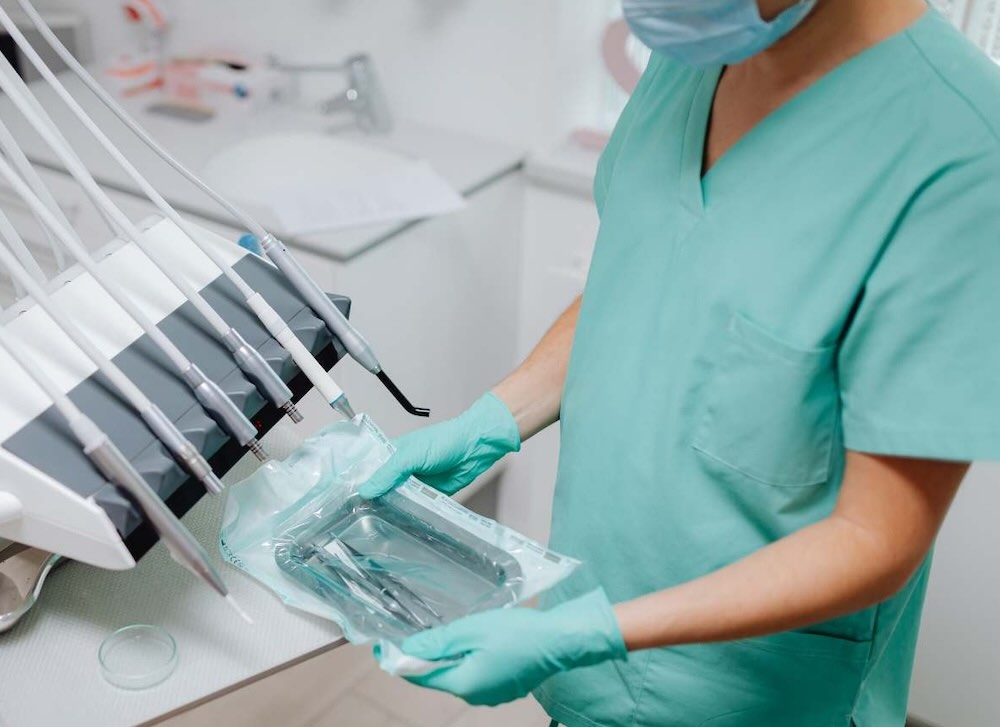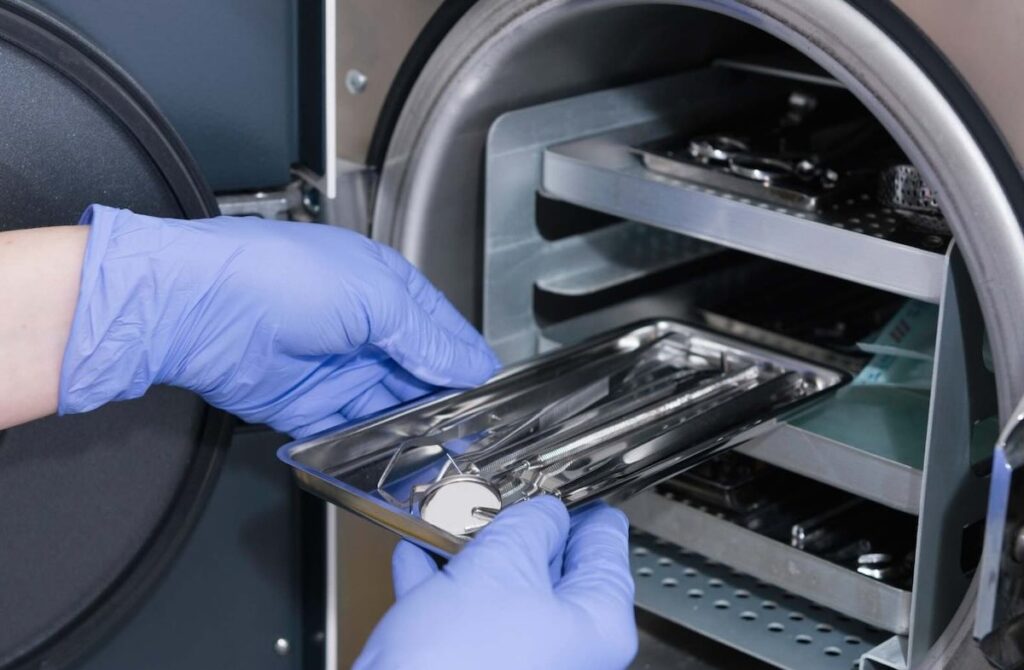Sterilizing surgical instruments is a regular and essential safety practice in surgery. Multiple sterilization methods serve different purposes.
Surgical sterilization methods use chemicals or physical means to destroy microbes on instruments. This article discusses the most effective and popular techniques that keep the devices in the operating room sterile.
What is sterilization?
By definition, sterilization of surgical devices is the elimination of all bacteria and microorganisms from the surfaces of the devices to prevent disease transmission. Sterilization usually is done before using the surgical instruments.
The instrument sterilization process involves:
- Pre-sterilization (cleaning, disinfection, and decontamination)
- Drying
- Packaging
- Heat sterilization
- Storage
- Monitoring sterile instruments
Autoclaving or steam sterilization
Autoclaving or steam sterilization is one of the safest and most popular sterilization methods for surgical devices. This method uses moist heat in the form of steam under pressure.
Steam sterilization is a go-to surgical sterilization method because it’s:
- Nontoxic and inexpensive
- Quick to destroy microorganisms and their spores (microbicidal and sporicidal)
- Quick to penetrate materials and heat them
Steam sterilization is commonly applied to metallic surgical instruments, as well as glassware. It’s also applicable to anesthesia equipment and all other heat- or moisture-resistant devices.
Like all sterilization methods, autoclaving can cause unwanted effects, such as corrosion and damaging the light function of laryngoscopes.
Steam sterilization of wrapped instruments is typically used:
- For 30 minutes at 121°C (250°F) in a gravity displacement sterilizer or
- For 3-4 minutes at 132–135°C (270–275°F) in a pre-vacuum sterilizer

Flash steam sterilization
Flash steam sterilization is a modification of autoclaving. As its name suggests, it happens in a flash. It involves sterilizing an unwrapped device at 132°C (270°F) for three minutes.
Flash steam sterilization is used for instruments that can’t be packaged and stored before use. It’s also useful when time is limited. But it’s not recommended for implants, such as orthopedic screws or plates.
Chemical sterilization using ethylene oxide gas (ETO)
Ethylene oxide gas (ETO) sterilization is a widely used surgical sterilization method. In fact, ETO is used on 50% of all sterile medical devices in the United States.
ETO is a colorless gas commonly used for sterilizing, among others:
- Metallic surgical instruments
- Devices that cannot withstand heat, steam, or moisture
- More specialized instruments, such as stents
- Plastic or resin instruments
- Glassware
- Devices with multiple layers, such as catheters
- Wound dressings and other general healthcare supplies
Surgical instruments must always be aerated, or exposed to air, after undergoing ETO sterilization.
Despite its wide range of applications, ETO sterilization takes time. It’s also expensive and potentially dangerous to patients and medical staff. Exposure to ethylene oxide is linked to several health-related complaints, such as:
- Skin and eye irritation
- Damage to the gastrointestinal or respiratory tract
- Central nervous system depression and dysfunction
- Cancer, polyneuropathies, and cataracts with chronic exposure
ETO sterilization is a type of low-temperature sterilization technology, using sterilants at(<60°C (140°F) to “cleanse” instruments.
Other members of this subgroup include gas plasma, vaporized hydrogen peroxide, and peracetic acid, as detailed below.
Hydrogen peroxide gas plasma sterilization
Hydrogen peroxide (H2O2) gas plasma sterilization is a novel low-temperature sterilization technique. It works by generating H2O2 gas plasma inside a chamber containing the surgical instruments. H2O2 can create hydroxyl and hydroperoxyl free radicals, which kill microbes in as little as 50 minutes.
H2O2 gas plasma has proven to be a very successful sterilant, used on devices including:
- Instruments sensitive to high temperatures and humidity
- Metal instruments vulnerable to corrosion
Just like ETO sterilization, H2O2 plasma gas sterilization should wrap up with aeration.
Liquid chemical sterilization (LCS)
This sterilization method uses liquid chemicals or sterilants to sterilize surgical instruments. The U.S. Food and Drug Administration (FDA) has approved several liquid chemicals for medical device sterilization, including:
- Peracetic acid
- Glutaraldehyde
- Chlorine dioxide
- Liquid hydrogen peroxide
Liquid chemicals are associated with more limitations than other sterilization methods, so they’re only recommended for critical cases. Such cases arise when dealing with heat-sensitive instruments or when other sterilization techniques don’t apply.
Peracetic acid sterilization
Peracetic acid is an example of a liquid chemical used for surgical instrument sterilization. It functions in low temperatures of around 50°C (122°F). This property makes it able to sterilize gastrointestinal or flexible endoscopes.
Dry heat sterilization
Dry heat is another popular sterilization method. It functions by trapping heat in a contained chamber containing the surgical instruments.
Pros of dry heat sterilization include:
- Environmentally friendly
- Easy-to-install and affordable
- Causes no metal corrosion
- Penetrates materials well
Dry heat sterilization works best for:
- Sharp metal instruments
- Instruments that can’t get wet
- Instruments wrapped in paper
- And for glassware, oils, and powders
The most notable disadvantage of dry heat for device sterilization is its length of time. It takes a while to penetrate the materials and kill the microorganisms. Dry heat is often applied at:
- 170°C (340°F) for 60 minutes,
- 160°C (320°F) for 120 minutes, or
- 150°C (300°F) for 150 min.
Ozone sterilization
Ozone (O3) forms when monatomic oxygen molecules collide with O2 molecules. Ozone has been used for decades as a drinking water disinfectant, and more recently, it’s been applied as a sterilant for surgical instruments.
Ozone sterilization is a safe technique. It produces no toxic gases or residues. It also uses low temperatures, avoiding the risk of accidental burns.
Ozone is able to sterilize instruments of various materials, like:
- Metal-based materials, like stainless steel, titanium, aluminum
- Additional materials like ceramic, glass, PVC, silicone, and acrylic
Other sterilization methods for surgical instruments
Certain sterilization techniques haven’t been as successful in sterilizing surgical instruments. This is why they’re not FDA-approved. Some of these techniques involve:
- Certain liquid chemicals – Difficult to monitor, time-consuming
- Microwaves – Associated with patchy, incomplete sterilization
- Infrared radiation – Newer and promising, but still being tested
- Ionizing radiation (gamma rays) – Costly, associated with side effects
- Ultraviolet light (UVL) – Not 100% effective, toxic to the skin and eyes, difficult to maintain
Formaldehyde steam deserves a special mention. Low-temperature formaldehyde steam is commonly used as a surgical sterilant in European countries. However, it’s highly carcinogenic and not as effective as ETO. As such, it’s not cleared for use in the United States.
No sterilization – disposable devices
Sometimes, sterilization can be avoided altogether. This is the case with disposable surgical instruments and implants. Disposable devices are single-use devices made of various materials, ranging from metals to plastic. After use, they are discarded.
Disposable devices can minimize the risk of infections. And they can prevent surgery delays or cancellations due to missing or contaminated instruments. Research shows disposable devices can also cut a large chunk of the costs associated with sterilization techniques.
However, disposable instruments may present a greater environmental risk if they are not disposed of responsibly and sustainably.

